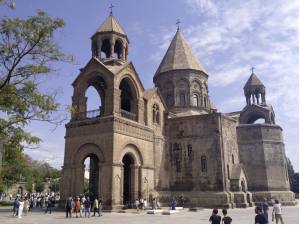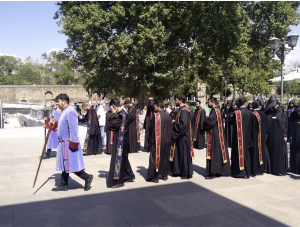by David Bishop
At Etchmiadzin Cathedral in the late morning on Sunday, September 14, many hundreds of Armenian Christian faithful crowded the ancient church to participate in the Divine Liturgy for the Feast of the Exaltation of the Cross. Dozens of clergymen led the faithful in a festal divine liturgy, led by an archbishop, which lasted over two hours.

Etchmiadzin Cathedral, as seen on the morning of September 14, 2025
Devoted to the Surb Khach, or Holy Cross, the feast of the cross is common throughout Eastern Christianity, being also one of the twelve Great Feasts of the Eastern Orthodox Communion. In the Byzantine branches of Orthodoxy, the feast commemorates the discovery in A.D. 326 of the True Cross of Christ’s crucifixion by Saint Helena, the wife of the Eastern Roman Emperor, Saint Constantine. In the Armenian Apostolic Church, however, the occasion of the Discovery of the Cross is celebrated on a separate date, October 27. The feast in September, meanwhile, celebrates the rescue of the True Cross from Persia in 628. While Eastern Orthodox celebrate both the discovery and rescue on the same date of September 14, the Armenian Apostolic Church separates these occasions into two holidays.
Multiple aspects make the Armenian celebration of the Feast of the Cross unique from any other Orthodox tradition in the world. Most obvious is the unique Armenian Rite of the Divine Liturgy, which was written by Saint Gregory the Illuminator (Surb Grigor Lusavorich), the patron saint of Armenia who was the first Catholicos of All Armenians after the conversion of Armenia to Christianity in A.D. 301. Also, it is notable that the Armenian Church practices a five-day period of fasting prior to the Feast of the Cross. This is one of the ten Monday-Friday fasts distributed throughout the year in the Armenian Church tradition. Finally, the Armenian church service for this feast uniquely concludes with a procession around the church, in which the four corners of the church building are blessed as a symbol of the sanctification of the world.

Armenian Orthodox clergymen begin the procession out of the Etchmiadzin Cathedral on September 14, 2025
In the Armenian Apostolic Church, the Feast of the Exaltation of the Holy Cross is the final and most solemn of the five major feasts that are devoted to the Cross. The Armenian Apostolic Church divides feast days into three categories: those devoted to Christ, such as Christmas on January 6; those devoted to the Mother of God (Surb Astvatstatsin), such as the Feast of the Annunciation on April 7; and the feasts of the Cross. Among all commemorations dedicated to the Holy Cross, this Feast of the Exaltation is the most significant, honoring its recovery from captivity, its elevation, and its glorification. The Feast is celebrated on the Sunday between September 11–17; this year it falls on September 14, the same day as for Eastern Orthodox brethren. The following Monday is designated as Memorial Day, with many Armenians visiting cemeteries and carrying on the tradition of honoring their departed loved ones.The next major feast will also commemorate the cross. The Feast of the Holy Cross of Varak, a holiday unique to only the Armenian Church, will take place on September 28.
As mentioned earlier,the origins of the Feast in the Armenian Church trace back to the early 7th century, when the Christian Byzantine Empire was at war with the Persians. In 610 A.D., Persian King Khosrov launched an assault on the Byzantine, or Eastern Roman, Empire. By 614 A.D., after a series of victories, the Persians entered Jerusalem. Countless lives were lost, and many, including the Orthodox Patriarch of Jerusalem Zakaria, were taken captive. The invaders seized the Holy Cross from the Church of the Holy Sepulcher, where it had been placed for veneration in the early 4th century by Queen Heghineh, mother of Emperor Constantine.
After years of warfare, in 628 A.D., the Byzantine army, led by Emperor Heraclius and supported by Armenian forces under Mzhezh Gnounie, entered Persian territory and sought to reclaim the Cross. By divine providence, the Byzantines prevailed. The Holy Cross was first brought to the Armenian city of Karin, then carried to Constantinople, and ultimately returned to Jerusalem. Along the way, it was elevated before the faithful for veneration.
For Christians, the Cross stands as a manifestation of God’s power and strength, the supreme emblem of faith and triumph. Sanctified by the innocent blood of Christ, it remains the eternal symbol of love, hope, and salvation for all humanity.


